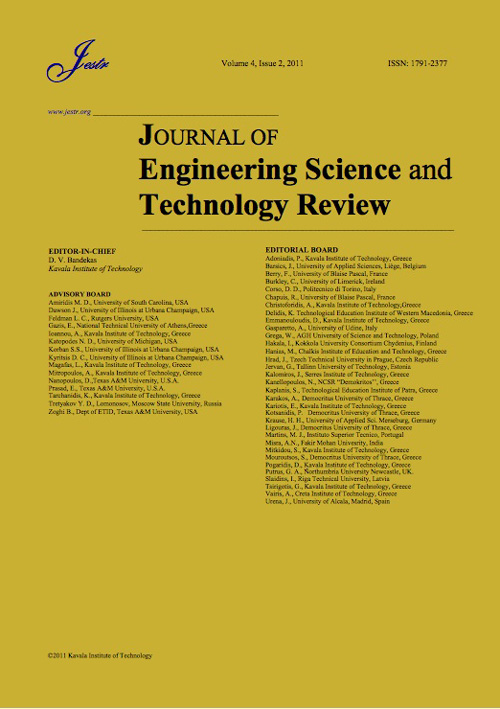Guidelines & Evaluation Process
1. Submission of PapersThe Journal of Engineering Science and Technology Review considers all manuscripts on the strict condition that they have been submitted only to the Journal, that they have not been published already, nor are they under consideration for publication or in press elsewhere. The Journal utilizes a fully digitized process for paper submission and review, via its online Editorial Management Platform. Authors who wish to submit their papers for review, need to register with editorialmanager.teiemt.gr and go through the paper submission process. Detailed guidelines are provided on Editorial Manager website.
2. Format of Papers
JESTR accepts submissions in English only. The submission should include a full text paper written in Microsoft Word format (docx), with Times New Roman, font size 12 points, 2 cm margins and formatted as A4 (or 8x11) paper size. Each page of the manuscript should be consecutively numbered. The manuscript should contain the article type (please see the aim and scope section of the Journal), title of the article, name(s) of the author(s), affiliation address(es), abstract, 3-5 keywords and will continue with the rest of the text. The text should be formatted double spaced. The text should not be interrupted by figures or tables. The text may be divided into sections with instructive headings, starting with Introduction and closing with Conclusion.
Equations should be typewritten by the equation editor of MS Word and should be placed in a separate line in the text. Equations should be numbered consecutively e.g. (1), (2), etc. Quoting an equation in the text should be given as Eq.1, etc. Equations should be capable of fitting into a two-column print format. Vectors and matrices should be in bold and variables in italic. If your paper contains superscripts or subscripts, take special care to ensure that the positioning of the characters is unambiguous. Exponential expressions should be written using superscript notation. After an equation is given the parameters that have not been explained before, must be given immediately after. Please, avoid defining each parameter on a separate line; treat them as normal text. Do not transfer equations in the text because there are marks that do not be provided by standard text font.
References and notes should be listed at the end of the manuscript in a separate page. Notes should be treated as the references. When citing a source within the text, use square brackets and numbers. For example: [1], [2], [3], etc. If you are citing multiple sources, separate the numbers with commas, like this: [4], [5], [6]. Use consecutive numbers for citations throughout the text. Reference List: Create a numbered list of references at the end of the article, ordered according to the order of appearance in the text. List all authors up to six; for more than six authors, list the first six followed by "et al." Italicize the titles of books, journals, and conference proceedings.
-
Journal Article:
- Author(s)' Last name(s) and Initial(s), "Title of the article," Abbreviated Journal Title in Italic, vol. X, no. X, pp. XXX-XXX, Month Year. Example: J. Smith and A. Johnson, "A study on renewable energy," IEEE Trans. Power Syst., vol. 25, no. 4, pp. 1785-1792, Dec. 2022. Conference Paper:
- Author(s)' Last name(s) and Initial(s), "Title of the paper," in Proceedings Title in Italic, Conference Location, Month Year, pp. XXX-XXX. Example: A. Brown and C. Lee, "Advancements in artificial intelligence," in Proc. IEEE Int. Conf. AI, San Francisco, CA, USA, Jul. 2023, pp. 25-32. Book:
- Author(s)' Last name(s) and Initial(s), Title of the Book in Italic. Publisher, Year. Example: R. Williams, "Introduction to Robotics." XYZ Publications, 2021. Thesis/Dissertation:
- Author's Last name and Initial(s), "Title of the thesis/dissertation," Ph.D. dissertation, Abbrev. Dept., Abbrev. Univ., City, Country, Year. Example: S. Lee, "Design and Control of Autonomous Drones," Ph.D. dissertation, Dept. of Aerospace Eng., Stanford Univ., Stanford, CA, USA, 2020. Website:
- Author(s) or Organization, "Title of the webpage," Name of Website in Italic. [Online]. Available: URL. [Accessed: Month Day, Year]. Example: National Aeronautics and Space Administration (NASA), "Mars Exploration Program," NASA. [Online]. Available: https://mars.nasa.gov/. [Accessed: Jul. 15, 2023]. Remember to consistently follow these guidelines throughout your manuscript for all the references you include. Using a citation management tool can also simplify the process of formatting references in IEEE style. Always verify the accuracy of your references before submitting your work to the scientific journal.
Tables should be numbered consecutively. Allow one page per table. On the top of each table should be a header (e.g. Table 1 Statistical data). Each table should be referred to explicitly in the text. Quoting a table in the text should be given as Tab.1, etc. Note that tables should be concise and again they must have a plain aesthetic. Avoid grey colours, too many lines, and other exaggerated presentations.
Figures should be numbered consecutively. Allow one page per figure. Each figure should be referred to explicitly in the text. Quoting a figure in the text should be given as Fig. 1, etc. Note that figures should depict only the necessary things and again figures must have an artistic aesthetic. Avoid boxes that explain the lines and the points of a graph, or grid lines, or headers, etc. Name the axes and when applicable define the scales in SI units. Provide an instructive caption, as lengthy as it needs, under each figure.
Algorithms should not be boxed and should be set as normal text, not as a figure or a table.
Computer code will be set in two columns. This means that a long line of computer code that fits on to one single-column page may have to be separated into two lines when typeset. Please take this into account when writing any code. Code may be typeset in the form of a figure to enable full-page-width.
Appendices and supplementary material e.g. mathematical derivations that may interrupt the flow of your paper's argument should form a separate Appendix section.
Acronyms and abbreviations should be clearly defined on their first occurrence in the text by writing the term out in full and following it with the abbreviation in round brackets.
Acknowledgments should appear between the Conclusions and References sections.
Copyright Licensing Agreement is required for all papers. These should be posted or faxed to the Editor once you have uploaded your paper.
3. Peer Review
The aim of peer review process is to ensure that high quality and original scientific studies are published. All published manuscripts in Journal of Engineering Science and Technology Review (JESTR) are peer reviewed, following the procedure outlined below.
Initial manuscript evaluation
All manuscripts are submitted for publication to JESTR via its online Editorial Management Platform. Authors who wish to submit their papers for review, need to register with editorialmanager.teiemt.gr and go through the manuscript submission process. Manuscripts are firstly evaluated by the Editor-in-Chief and one of the Co-Editors, responsible for the scientific area that the manuscript deals with. At this stage manuscripts may be rejected without peer review if it is felt that they are not of high enough priority or not relevant to the Journal. This fast rejection process means that authors are given a quick decision and do not need to wait for the review process.
Policy of peer review
Journal of Engineering Science and Technology Review employs double blind reviewing, where both, reviewers and author, remain anonymous throughout the process. The reviewers are not members of the Journal's Editorial Board.
Peer Review Process
Manuscripts that are not instantly rejected are sent out for peer review, usually to two independent reviewers who are determined by the Co-Editor, responsible for the scientific area that the manuscript deals with. Manuscripts may also be sent out for statistical review. The peer review process takes place entirely on JESTR Editorial Management Platform, where all reviewers are registered as well. Reviewers are chosen from the Journal's reviewers list or, when necessary, after online search, according to their expertise.
Reviewers are asked to evaluate the manuscript's originality, methodology, contribution to the literature, presentation of results and support for the conclusions, and appropriate referencing of previous relevant studies. They might accept the manuscript, reject the manuscript or might require a minor or major revision for style and/or content. For the publication of papers, two positive reviews are required. In case one reviewer's report is negative while the other is positive, the paper is forwarded to a third reviewer for additional evaluation.
When a revision is recommended by the reviewer or reviewers, the author(s) are obliged to proceed making those proposed adjustments to their paper, taking into consideration their specific feedback and suggestions, and then resubmit the revised version of manuscript within a week. Revised manuscripts resubmitted after this deadline of one week will be considered as a new submission and peer review process will start from the beginning. Reviewers may request more than one revision of a manuscript. Manuscripts which are not accepted for publication are not resent back to their authors.
Final Evaluation
After the favorable opinions of reviewers, the paper is accepted for publication by the Editor-in-Chief and the responsible Co-Editor and is placed in an issue sequence.
Time of Peer Review Process
The peer review process that takes a long time is an important problem. Naturally, the author(s) wish to take an answer about their submissions soon enough. Journal of Engineering Science and Technology Review aims to complete this process within 4 months after submission.
The author(s) that submit a paper to the Journal of Engineering Science and Technology Review are considered as accepting all above mentioned peer review conditions and procedures.
Originality
By submitting your manuscript to the Journal it is understood that this it is an original manuscript and is unpublished work and is not under consideration elsewhere. Plagiarism, including duplicate publication of the author's own work, in whole or in part without proper citation is not tolerated. Manuscripts submitted to the Journal are checked for originality using anti-plagiarism software.
Journal of Engineering Science and Technology Review uses Ephorus (Turnitin) anti-plagiarism software to detect instances of overlapping and similar text in submitted manuscripts. Ephorus (Turnitin) is an online service for screening published and submitted content for originality and highlighting potential plagiarism.
4. Copyright, Licensing, Publishing Rights
Your contribution must be original work that has not been published previously, has not been accepted for publication elsewhere and is not under consideration for publication by any publisher in any print or electronic media.
All papers published in Journal of Engineering Science and Technology Review are open-access papers, published and distributed under the Creative Commons Attribution 4.0 International Public License, which permits reproduction, distribution, derives and commercial use, provided the original work is properly cited and authors and publisher are properly identified. Every reprint must contain a reference to the original publication in "Journal of Engineering Science and Technology Review", including reference to the corresponding Issue. The authors retain the copyright of their work for all papers published in this Journal. It is the author's responsibility to obtain signed permission from the copyright holder to use and reproduce text, illustrations, tables, etc., published previously in other Journals, electronic or print media. The signed permission letter must be submitted together with the signed cover letter. Authors are required to disclose any sponsorship or funding received from any institution relating to their research.






